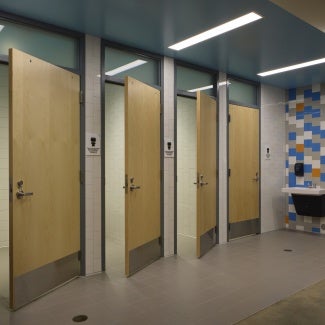Spreading construction specifications firm knowledge
Author: Deltek
An experienced design professional's wealth of knowledge is critical to well-coordinated construction specifications. Learn how to increase and transfer knowledge across your firm to boost project efficiency and drive long-term success.

A blueprint for delivering great work
Design professionals' wealth of knowledge, experience, and technical expertise is critical for developing high-quality, well-coordinated construction specifications. Over time, many A&E firms can accumulate vast knowledge, experience, and industry expertise. However, in many cases—particularly if your company does not have a way to record or preserve that information—when an employee leaves the company, valuable knowledge can be lost.
In this article, you will learn three ways to increase knowledge across your practice to boost project efficiencies, foster greater collaboration, and set up your company for long-term success.
1. Cultivate better decision-making
Fostering an environment of best practices is ideal for any company. In addition, you enable better decision-making by cultivating a culture where learning from each other is part of the standard way of working.
Here are five resources for developing a construction specification best practice:
- A standard answer to the same problem or question during construction
- Information or knowledge from past projects
- Golden nuggets captured within the contract documents
- A construction method or process
- A lesson learned from a specification or drawing
Best Practices can also be proactive. For example, an employee can identify a potential issue or question before it arises and bring it to the decision-maker for the possible creation of a best practice.
Within a company, every employee should have access to and be able to request a best practices document. However, not everyone should be able to contribute to those best practices. Best practices should have a dedicated point of contact to streamline the process. Having a point person ensures a best practices document is in a consistent format for the reader. Best practices should be concise, to the point, and easily accessible. Learn more in the educational webinar: Increase Project Efficiencies with Best Practices.
No matter the situation, employees should always have access to their company’s best practices. Furthermore, these practices should always be dynamic, change over time, and be frequently updated.
2. Boost efficiency & competency
Specification writing for construction projects is essential and time-consuming work. In them, the design professional stipulates, in full detail, the range of acceptable construction materials, manufacturers, and systems for every aspect of a construction project. To learn how an AE firm saves time and leverages industry standards to simplify specification writing, look at Kingdom Design Group.
Developing architectural specifications and best practices can boost efficiencies and increase competencies. Here are examples of best practices:
- Design standard: Always place the resistive weather barrier behind the continuous insulation. Only specify tamper-resistant screws on educational projects.
- Revit Template/families: Use 14-gauge hollow metal doors for education projects and families with hospital stop frames for hospitals. When creating an ornamental fence, do not use curtain wall mullions; instead, use an ornamental family.
- Manufacturers and product types: Only specify Manufacturer A on projects from this owner/developer. Only use impermeable weather resistive barriers on projects in climate zone X. Always specify an ASTM F3010-compliant moisture mitigation product.
- Construction administrative requirements: Always require the contractor to submit installer requirements and require pre-installation meetings on these products. For Division 01 requirements, you may have specific Division 01 sections depending on if the project is design-build, design-bid-build, construction management, etc.
- Assembly composition: With the cement plaster assembly, always specify thermal insulation > exterior sheathing > resistive weather barrier > continuous insulation > lath > plaster.
3. A better way of collaborating
Collaboration begins the moment you start planning a project. Cooperatively working with one another using resources to foster a collaborative environment means the project will benefit the client. Learn more about construction specification strategies that deliver better-built projects in the article: Proven specification strategies for better-built projects.
By sharing information and knowledge, we can break down the silos within the industry. It takes communication to understand the goals of each stakeholder in the project. The values and plans may need to align, but everyone can get on the same page by understanding and communicating. Sharing best practices supports better decision-making and minimizes project issues. Project teams that adopt a collaboration mindset based on best practices will reap many benefits, including:
- Fewer changes and rework
- On-time project delivery
- Projects that stay on-budget
- Fewer contract disputes
- Happier owners and other project stakeholders
Conclusion
Sharing best practices across your organization is an excellent way to improve overall performance and productivity. Regardless of the size of your group, team, or company, capturing and communicating your team's experiences and knowledge will accelerate learning for all involved. No matter their level of experience, everyone has something to share. Invite your employees to share their best practices. You never know who might come up with the newest and best idea.
Explore the possibilities
The AEC industry is reshaping how it builds and manages projects, which means implementing modern technology. Deltek and AIA have teamed up to deliver Deltek Specpoint, home of AIA MasterSpec®, which consists of comprehensive online building product research and selection content combined with a streamlined specification design and publishing tool that pulls from decades of experience serving the industry’s specialized needs. Learn more here.
About Deltek
Better software means better projects. Deltek is the leading global enterprise software and information solutions provider for project-based businesses. More than 30,000 organizations and millions of users in over eighty countries worldwide rely on Deltek for superior project intelligence, management, and collaboration. This includes over 11,000 architecture and engineering firms, representing 80% of the Engineering News-Record (ENR) Top 500.



